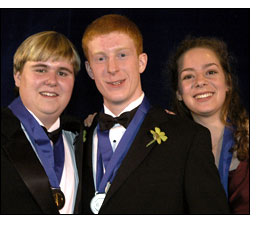WASHINGTON, D.C., March 17 -- David Vigliarolo Bauer of Bronx, N. Y., was the first-place winner of a $100,000 scholarship in the 2005 Intel Science Talent Search high-school science competition.
Bauer, 17, of Hunter College High School, designed a new method using quantum dots (florescent nanocrystals) to detect toxic agents that affect the nervous system. Bauer believes his research could save thousands of lives by rapidly evaluating individual exposure to these agents.

The top three winners of the 2005 Intel Science Talent Search. Left to right: David Vigliarolo Bauer, first place; Timothy Frank Credo, second place; and Kelley Harris; third place.
The second-place prize, a $75,000 scholarship, went to Timothy Frank Credo, 17, of the Illinois Mathematics and Science Academy, in Highland Park, Ill. Credo developed a more precise method to measure very brief intervals of time -- picoseconds (trillionths of seconds) -- over which charged secondary particles of light travel.
The $50,000 third-place scholarship went to Kelley Harris, 17, of C.K. McClatchy High School, in Sacramento, Calif. Harris studied Z-DNA binding proteins, which may play a role in cell responses to certain virus infections.
Fourth- through sixth-place winners each receive a $25,000 scholarship: Robert Thomas Cordwell, 17, Manzano High School, Albuquerque, N.M., for his project, "Some Results on Inclusive and Exclusive Partitions of Complete Graphs"; Ryan Marques Harrison, 17, Baltimore Polytechnic Institute, Baltimore, "A Novel Approach to Modeling pH-sensitive Regions Within Proteins"; Lyra Creamer Haas, 17, Illinois Mathematics & Science Academy, Aurora, Ill., "Using Textiles to Date Sites in the Norte Chico, Peru".
Seventh- through tenth-place winners receive $20,000 scholarships: Justin Alexander Kovac, 17, Montgomery Blair High School, Silver Spring, Md., for his project, "The Effects of Warm Core Rings on Hurricane Intensification in the Gulf of Mexico"; Karl James Plank, 17, Squalicum High School, Bellingham, Wash., "Toward Self-Assembling Nanocircuitry Using Liquid Crystal Solvents"; James Andrew Cahill, 18, Flagstaff High School, Flagstaff, Ariz., for his project, "Assessment of Equinoctial and Cross Quarter Alignments of Anasazi Origin in the Lomaki Pueblo of the Wupatki National Monument"; Po-Ling Loh, 18, James Madison Memorial High School, Madison, Wis., "Closure Properties of D2p in Finite Groups."
The remaining 30 finalists receive $5000 scholarships, and each student attending the competition received an Intel Centrino mobile technology-based notebook computer. More than 100 scientists from a variety of disciplines reviewed 1600 entries from 47 states, Puerto Rico and the District of Columbia in this year's competition. The students ranged in age from 15 to 18; females represented half of the entries.
For more information, visit: www.intel.com